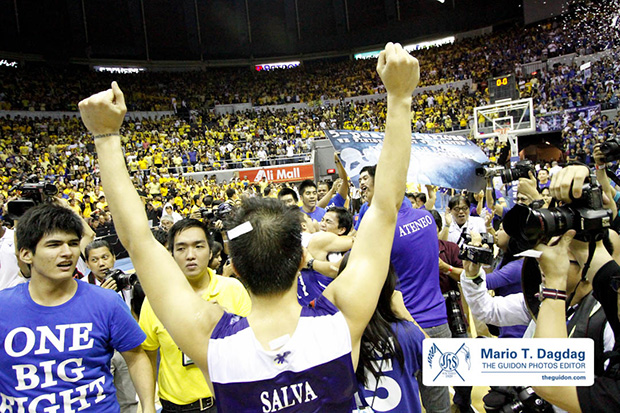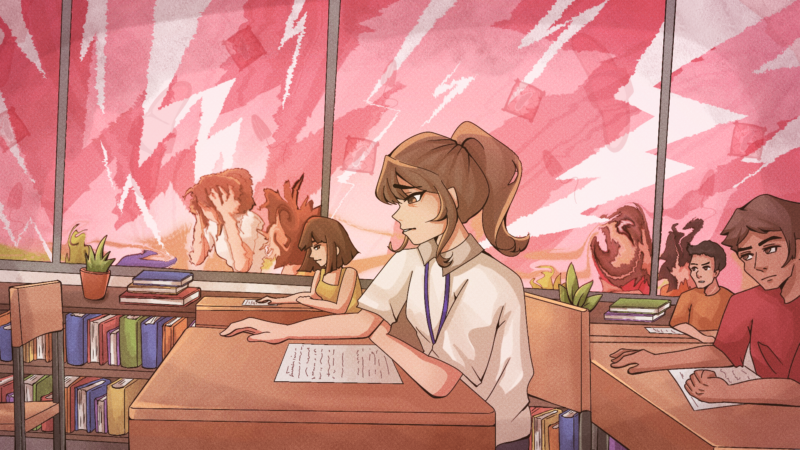
THE ULTIMATE RETURN. Supporting a varsity team entails a big investment that will hopefully yield a championship title. Photo by Mario T. Dagdag.
EVERY YEAR, the University Athletics Association of the Philippines (UAAP) holds tournaments for 16 different sports. With each sport having a men’s and women’s division, 32 teams go off to represent Ateneo in the most esteemed collegiate tournament of the nation.
Imagine the gargantuan task of providing for all the needs of these teams. From uniforms, to sports equipment, salaries and other operating expenses, all the essentials of all accredited Ateneo varsity teams are provided for by the university.
One thing is for sure: it’s neither easy nor cheap to sustain a collegiate varsity team—much less a winning tradition.
Taking care of business
Ateneo has two offices instituted to take care of and maintain all varsity teams. The University Athletics Office (UAO) handles all external aspects of the business of a varsity team: sponsorships, representation in the UAAP and in other tournaments, international competitions if any, equipment and budget for the UAAP.
The College Athletics Office (CAO), on the other hand, deals with the internal aspects, which include the needs of the student-athlete, such as monitoring academic standings, athletic insurance, load revisions, budget for accredited non-UAAP teams, and the salaries of coaches (except for the men’s basketball team). According to CAO Coordinator Benjo Afuang, the office handles “everything concerning the student life of the athlete.” One of the latest projects of the CAO is the study hall for athletes, located at the third floor of the Blue Eagle Gym.
Funding
The budget used to run all of Ateneo’s sports programs and teams comes from revenue acquired from university operations, such as tuition fees. The UAO handles the allocation and disbursement of the budget to the UAAP teams while the CAO does the same for non-UAAP teams.
All of the necessary expenses associated with running a team are covered by the yearly budget that is allotted for the UAO and the CAO. Aside from purchasing equipment and uniforms, other operational expenses include payments for training venues and transportation costs. Athletic scholarships, meanwhile, have a separate budget.
The biggest expense, however, would be the salaries of the coaching staff. “Some teams really need more than two coaches,” explains Afuang. “There’s a head coach and then there are other specifics. Some can live with two or even three, but some teams need more.”
Slicing the pie
Allocating the budget among all the different teams is a meticulous process. Due to the diverse variables involved in each sport, the pool of funds is not evenly distributed among the different teams.
“We don’t quantify [the budget] in terms of peso value but in terms of needs,” explains Emmanuel Fernandez, the assistant director for operations of the UAO. “The cost differs per team. Comparing chess to baseball, for example, jerseys are already different and there are a different number of players.” Fernandez points out that uniforms for one Blue Booter cost P2,500 t0 P3,000 for a football team composed of 20, compared to a chess team of six that only needs shirts that cost P1,500.
Afuang says that the baseball and softball teams have the biggest budget costs. Next would be the swimming and judo teams, chiefly due to the costs of the uniforms. “The judogi for one judo player costs P25,000 and the jammers used by the swimming team members cost P8,000,” says Fernandez.
Aside from needs, the school is not hesitant to invest in technology to give the best for the players. “For volleyball teams, instead of having the shorts sewn somewhere else, we use Nike pros, which is twice as expensive because of the technology by Nike,” shares Fernandez. “Notice the uniforms by the volleyball teams of Adamson and La Salle. Their shorts are already loose while they have compression shorts inside, but ours don’t. It’s better for your muscles too.”
While many have always complained about the Blue Eagles seemingly receiving majority of the budget, they actually receive one of the smaller shares. The community, however, is right to think of the basketball team as the most expensive one in the university, but various benefactors and sponsorship deals cover most of the team’s operating expenses.
Invisible hand
Despite being provided with an annual budget, it is not enough to build and sustain a championship athletics program on its own. This is why cash flows also arrive via benefactors. And there is no bigger name right now in that regard than longtime Blue Eagles patron Manuel V. Pangilinan.
Pangilinan, however, is not alone. The success of the badminton program would not have been possible if not for the help of Frederick Go. His support has allowed the Blue and Lady Shuttlers to build a winning tradition these past couple of years—both teams have earned first runner-up finishes and championship titles in the last two years.
Meanwhile, the university’s swimming program has Cecilio Pedro, whose support helped the Blue Tankers translate their Season 75 campaign into their first championship.
The Ateneo women’s volleyball team, more popularly known as the Ateneo Lady Spikers and arguably the most recognized team on campus next to the men’s basketball team, has Tony Yao, whose support has contributed to the team’s transformation into a title contender.
“Those are just some of the names,” says Afuang. “There are a lot, actually. They might not be big names, but collectively they give support.”
The UAO is also always looking for benefactors. The P20 million needed for the track oval, which is currently under construction, was acquired through many generous donations from the alumni.
Nike
A vital component when it comes to funding college athletics are the sponsorship deals the university has entered into. “One of the things that helped us a lot was the contract with outfitters. It started with Adidas then Nike. We get the uniforms and shoes from Nike,” shares Afuang. “Nike covers everything and we don’t worry about anything anymore.”
“The difference with Nike and Adidas is that the latter did not enter high-end uniforms for our teams; they were not genuine,” expounds Fernandez. “That’s why we’re happy with Nike. That’s why we invest highly in Nike.”
The Archers’ way
In comparison, Ateneo’s methods of funding its teams are similar to other UAAP schools. For De La Salle University, the Office of Sports Development handles the funding of its college athletics program.
Henry Atayde, the current president of the Union Mondiale des Anciens Élèves Lasalliens, calls sponsorships an “important element” in the entire process of funding collegiate teams. Atayde, however, strongly emphasizes the importance of alumni in college athletics. “It’s always a partnership between the school and alumni,” he insists.
Sustainability
Amidst all the challenges in funding collegiate teams, Ateneo will always have more than enough help coming from sponsors and alumni.
The newly instituted Sports Endowment Fund (SEF) is a step further towards making a sustainable fund for maintaining the different athletic programs and preserving Ateneo’s winning tradition.
The SEF is the realization of a vision of university president Fr. Jose Ramon Villarin of an umbrella fund that would support all Ateneo sports. “The endowment fund will alleviate operations,” says Fernandez. “This means you have more money for academics and other areas for school operations. Thus, you don’t have to rely on sponsors and it makes you self-sufficient.”
With reports from Mateo L. Escueta and Angelo F. Herbosa
Editor’s Note: The GUIDON also sent requests to interview officers of the athletics offices of National University and the University of Santo Tomas regarding their respective systems for funding their athletic programs, but these requests were not granted. The UAO also declined to comment on inquiries regarding the total amount or cost of the budget for Ateneo athletics.
What do you think about this story? Send your comments and suggestions here: tgdn.co/2ZqqodZ







